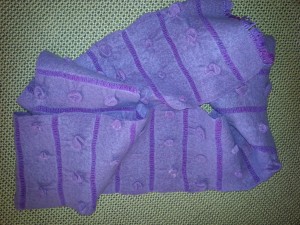The “dogs” come to all weavers- especially if they have been weaving for any length of time. Sometimes, the dog is a warp and it “woofs” at you every time you pass it by. Other times the dog shows up as finished material that is good for –what? It’s too stiff, too sleazy, too many mistakes or just plain UGLY!

Yes! This is a certifiable dog.
Now, this dog could spend the rest of your life hiding in the back of a closet or in some long forgotten storage box–but who needs such space hogs?
The above opens the discussion of what to do with the dogs.
1.) Give it to a friend or an enemy.
Problem: that person will know who wove it.
2.) Bury it in some secret place where nobody goes.
Problem: Too much work and definitely too strenuous.
3.) Use the material to make dog or cat beds.
Problem: It’s a lot of work for an unthankful animal.
4.) Consider the “dog” free material to use in trying out new techniques: felting, surface design, quilt pieces, applique and over dyeing.
I will admit that I have had my share of “dogs” in 34 years of weaving. I also admit that I consign these pieces to storage for months and sometimes years. Occasionally, when they are resurrected they look better and I can appreciate their potential. Mostly, they are still “dogs.”
I used suggestion #3 (dog beds) for years. The dogs loved them and I felt I was getting a somewhat reasonable return on my investment of time and money. Recently, I’ve come into a lifetime supply of commercial fabric samples. These are now my go to source of material for dog bed construction and they look more finished than the darned loom “dogs.”
Therefore, lately I’ve been using #4 when I uncover a long forgotten “puppy.”
A case in point: I recently unearthed about 6 yards of the ugliest pink fabric ever. It was so bad that I couldn’t remember when or why I wove it.
I took it to our guild’s “weavers’ study group” as an example of how bad a weaving could be and, also, to show that even an experienced weaver can make a mistake.
Being women and weavers, they tried to be soothing and encouraging. “That’s not so bad,” they murmured (while privately asking themselves why I wove six yards of it!)
One of the group suggested that maybe dyeing it would help. During the next few days I pondered the possibility of dyeing – but the material was so uninteresting that I thought it would need something else. Maybe I could incorporate a shibori technique, too.
With the project planned, I bought a bottle of RIT dye in Purple and a selection of wooden and plastic beads. I then wrapped the beads in sections of the fabric and secured them with hairbands, rubber bands and electrical ties to hold them in place.
The material was thrown into the washing machine for a dye bath in very hot water and was agitated for 30 minutes.
This material had been washed before so I was very amazed to find a very much shrunken and board-like material at the end of the dyeing process.
After drying it and removing the beads, I had another surprise. This fabric was covered in fairly evenly placed nipples where the beads had been. Somehow I hadn’t expected that!
The shibori idea was a bust. Only the beads tied with the electrical ties had been tight enough to give me a two tone circle where they had been. The hairbands just got a got a purple over-dye.
I’m back to thinking what to do -if anything – to this material. Perhaps it needs to be buried in storage for several more years.